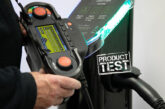
Roger Bisby tries on a pair of Base work boots from Brian Hyde and considers how far safety footwear has come.
It seems to me that every time I try out a new pair of work boots or shoes they blow my socks off. I am talking metaphorically, of course, but the innovation that now goes into protective footwear means that we are constantly breaking new ground. It wasn’t always the case – a few years ago you really knew you were wearing steel toe caps. It was purgatory – as the day wore on your feet would begin to drag and, if you weren’t careful, you would find yourself not quite lifting your foot high enough and then, of course, you would trip.
There is irony in a pair of safety boots that make it more likely you will fall over, but it is the case with a great deal of footwear. When we pointed this out the health and safety guys wouldn’t believe us – they thought we were whingers looking for an excuse to return to trainers – but I know loads of builders and roofers, in particular, who find it really difficult to work safely in the old style work-boots.
“This latest range from Base has been redesigned from the ground up to address every complaint in the book. The Italian-styled boots and shoes are lightweight, flexible and breathable.”
Fortunately, some manufacturers took a more positive view and responded to the call for lighter, more flexible footwear that still offered the required protection. This latest range from Base has been redesigned from the ground up to address every complaint in the book. The Italian-styled boots and shoes are lightweight, flexible and breathable. Try them once and you won’t go back to the old style boot or shoe.
The amazing level of impact cushioning in the sole and heel  is achieved with tiny air bubbles injected into the polyurethane, and it takes the shock when you walk. In terms of comfort they remind me very much of Doc Martin’s. This becomes even more apparent when you are carrying heavy weights because, ultimately, all that extra weight ends up in your poor old feet. The soles are also made more flexible by taking out the steel strip that so many safety boots have and replacing it with ballistic grade Kevlar.
is achieved with tiny air bubbles injected into the polyurethane, and it takes the shock when you walk. In terms of comfort they remind me very much of Doc Martin’s. This becomes even more apparent when you are carrying heavy weights because, ultimately, all that extra weight ends up in your poor old feet. The soles are also made more flexible by taking out the steel strip that so many safety boots have and replacing it with ballistic grade Kevlar.
But it doesn’t stop there – the toe cap is also a major leap forward. It is a non-metallic composite material that is thinner and lighter than metal toe caps but still meets the impact and compression standards. If you happen to have your toe run over by the digger it should survive. I mean your toe, not the digger, but I don’t recommend this as a test and I certainly wasn’t about to try it. What I did do was wear these boots on site – and after a week I can say that they aren’t going back. My only criticism is that they were hard to put the laces in. There are no metal eyelets, so you have to use a wire nail to align the holes from the outer leather to the inner breathable liner. It is no big deal but I have been known to get
through a pair of boot laces in three weeks, so I hope that putting the next set of laces in is quicker and easier.
Would that small point put me off buying these boots? You must be joking – they are such a big step forward for safety footwear that, once tried, it is impossible to imagine settling for anything less.
Remember that a lot of back problems come from poor support and impact from the feet, so don’t treat them like a poor relation – give your feet a treat, you won’t regret it.








